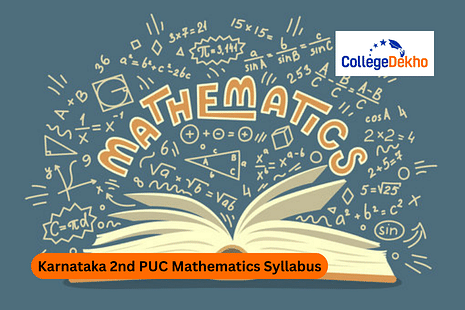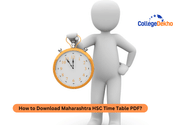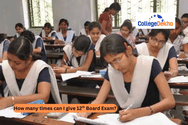

Never Miss an Exam Update
Karnataka 2nd PUC Mathematics Syllabus 2025-26 is set by the Karnataka board. The Mathematics syllabus includes 13 topics which further include different parts. Prepare the syllabus for a theory exam of 80 marks. The remaining 20 marks will be reserved for internal assessment. You can fix a time limit for each of the chapters and try to complete it within the duration. Among all the chapters, Integrals has the highest marks. You can check the marks allotment for each of the chapters and pay more attention to the chapters with more marks. By completing the 2nd puc maths syllabus 2025-26 in advance, students will be able to revise the chapters and solve questions. For more details about the Karnataka 2nd PUC Mathematics Syllabus 2025-26, continue reading the article.
Latest Updates:
December 11, 2025: The Karnataka board will conduct the exam in three phases. The Karnataka 2nd PUC exam 1 2026 will be conducted from February 28 to March 17, 2026. Check the Karnataka 2nd PUC Time Table 2026 in detail and note the exam dates for your subjects.Karnataka 2nd PUC Mathematics Syllabus 2025-26: PDF
The official PDF for the 2nd puc maths syllabus will be provided here:
Karnataka 2nd PUC Mathematics Syllabus 2025-26 |
|---|
Also Read - Karnataka 2nd PUC Mathematics Previous Year Question Paper
Karnataka 2nd PUC Mathematics Syllabus 2025-26
Students can check the detailed information about the important topics included in each unit for the 2nd puc maths syllabus 2026 from the table given below. Try to complete your 2nd puc mathematics syllabus as soon as possible to continue with your revision:
Units | Important Topics |
|---|---|
1. Relations and Functions | Types of relations: universal and equivalence relations, transitive, empty, reflexive, etc. |
2. Inverse Trigonometric Functions | Types of functions: the inverse of a function composite functions, One to one and onto functions, Binary operations, etc. |
3. Matrices | Matrices Concept, Types of matrices, Algebra of matrices, Symmetric and skew-symmetric matrices, Simple properties of addition, multiplication and scalar multiplication. Oncommutativity of multiplication of matrices and existence of non-zero matrices whose product is the zero matrix (restrict to square matrices of order 2). Invertible matrices and proof of the uniqueness of inverse, if it exists; (Here all matrices will have real entries) |
4. Determinants | Determinants, Determinants of a matrix of order 3 × 3, Area of a triangle, co-factors, minors, and determinant applications in calculating a triangle's area. A square matrix's inverse and adjoint. Using the inverse of a matrix, solve systems of linear equations in two or three variables (with a unique solution) to determine consistency, inconsistency, and the number of solutions. |
5. Continuity and Differentiability | Continuity, continuous functions, derivative of composite functions, Differentiability, implicit functions' derivative, Understanding logarithmic and exponential functions, logarithmic and exponential function derivatives, Derivative of functions given in parametric forms, logarithmic differentiation, derivatives of second order |
6. Applications of Derivatives | Applications of derivatives include body change rate, growing and decreasing functions, and maxima and minima (the second derivative test is provided as a proven tool, while the first derivative test is motivated geometrically). Simple problems (that show fundamental ideas and comprehension of the subject matter in addition to real-world scenarios). |
7. Integrals | Integration as inverse process of differentiation, Integration of a variety of functions by substitution, by partial fractions and by parts, Evaluation of simple integrals of the following types and problems based on them, Fundamental Theorem of Calculus (without proof). Basic properties of definite integrals and evaluation of definite integrals |
8. Applications of the Integrals | Definition, general, and order solutions of a differential equation. Solution of homogeneous differential equations of first order and first degree; solution of differential equations by method of separation of variables. Solutions to the following kind of linear differential equation: dy dx + py = q, where p and q are constants or functions of x. d? d? + px = q, in which p and q are constants or functions of y. |
9. Differential Equations | Scalars and vectors, as well as a vector's direction and magnitude. vector's direction cosines and direction ratios. vector types (equal, unit, zero, parallel, and collinear), vector components, vector addition, vector multiplication by a scalar, position vector of a point dividing a line segment in a given ratio. Definition, Geometrical Interpretation, properties and application of scalar (dot) product of vectors, vector (cross) product of vectors. |
10. Vector Algebra | Types of vectors, addition of vectors, etc. |
11. Three Dimensional Geometry | A line connecting two places' direction cosines and direction ratios. The shortest distance between two lines, skew lines, and the Cartesian and vector equation of a line, angle formed by two lines. |
12. Linear Programming | Introduction, related terminology such as constraints, objective function, optimization, graphical method of solution for problems in two variables, feasible and infeasible regions (bounded or unbounded), feasible and infeasible solutions, optimal feasible solutions (up to three non-trivial constraints). |
13. Probability | Conditional probability, multiplication theorem on probability, independent events, total probability, Bayes’ theorem, Random variable and its probability distribution, mean of a random variable. |
Also Read: Karnataka 2nd PUC Mathematics Model Paper 2025-26
To prepare for the Karnataka 2nd PUC Mathematics board exams, it's important to finish the 2nd puc syllabus 2025-26 by early January. To aid in revision, it's recommended to download the blueprint and model test papers from the official KSEAB website. Keep visting the page at regular intervals to get the latest updates.
Are you feeling lost and unsure about what career path to take after completing 12th standard?
Say goodbye to confusion and hello to a bright future!

FAQs
The Karnataka board allows students to appear thrice for the 2nd PUC Mathematics exams 2025-26. The best score will be considered for the final result. Hence, you have a chance to improve your marks.
The students need at least 35% marks in the Karnataka 2nd PUC Mathematics exam 2025-26 to get the pass status. If students fall short of a few marks, they can be awarded with upto marks.
The most important chapter in Karnataka 2nd PUC Mathematics Syllabus 2025-26 is Integrals. This chapter holds the most amount of weightage which is 20 marks. Try to complete the most important chapter first and then move on to the rest of the chapters.
Students can easily complete the Karnataka 2nd PUC Mathematics Syllabus 2025-26 by creating a study plan and allotting specific timings to each chapter. Study in small intervals everyday to retain information without confusing yourself.
Karnataka 2nd PUC Mathematics Syllabus 2025-26 consists of chapters like Relations and Functions, Inverse Trigonometric Functions, Matrices, Determinants, Continuity and Differentiability, Applications of Derivatives, Integrals, Applications of the Integrals, Differential Equations, Vector Algebra, Three Dimensional Geometry, Linear Programming, and Probability.
Was this article helpful?



















